 Near Eastern Tribal Societies during the Nineteenth Century
Near Eastern Tribal Societies during the Nineteenth Century The Tiyaha had large camel and goat herds, and in the areas of the Negev where it was feasible they practiced agriculture. Their protection of the Hajj route between Jebel Husn and Nakhl was also lucrative, particularly since they could claim taxes on the goods sold in the Nakhl market. Apart from that, in the 1930s they still had the monopoly on guiding the route from Gaza to Nakhl. They had a complicated arrangement with the Towara, who had the guiding and protection rights to the south and west of Nakhl.
(Von Oppenheim 1943: 148)Introduction
The more romantic descriptions of Bedouin often describe them as nomadic pastoralists, wanderers, avoiding the settled lands, continually on the move with their camels, doing a bit of raiding and robbing on the side. This image derives largely from the Rub' al-Khali, the “empty quarter” of Arabia, where people like Harry St John Philby (1933) and Bertram Thomas (1938) saw the Murra living mostly on camel's milk, with some gazelle or hare from the hunt; camping in small groups to make the most of the small patches of pasture in a dry desert, where rain seldom fell; expert trackers, raiding and being raided in turn.
In ancient times, Egyptian Bronze Age inscriptions and Assyrian and Babylonian documents also associate kin-based nomadic societies with pastoralism, as well as with a warlike, aggressive nature, opposed to settlement and government control. According to the Bible, long seen as the ultimate source of information for the region, the patriarchs of the Tribes of Israel were goat, sheep and camel breeders, wandering nomads, until they wandered into the Promised Land and became settlers.
To save this book to your Kindle, first ensure [email protected] is added to your Approved Personal Document E-mail List under your Personal Document Settings on the Manage Your Content and Devices page of your Amazon account. Then enter the ‘name’ part of your Kindle email address below. Find out more about saving to your Kindle.
Note you can select to save to either the @free.kindle.com or @kindle.com variations. ‘@free.kindle.com’ emails are free but can only be saved to your device when it is connected to wi-fi. ‘@kindle.com’ emails can be delivered even when you are not connected to wi-fi, but note that service fees apply.
Find out more about the Kindle Personal Document Service.
To save content items to your account, please confirm that you agree to abide by our usage policies. If this is the first time you use this feature, you will be asked to authorise Cambridge Core to connect with your account. Find out more about saving content to Dropbox.
To save content items to your account, please confirm that you agree to abide by our usage policies. If this is the first time you use this feature, you will be asked to authorise Cambridge Core to connect with your account. Find out more about saving content to Google Drive.